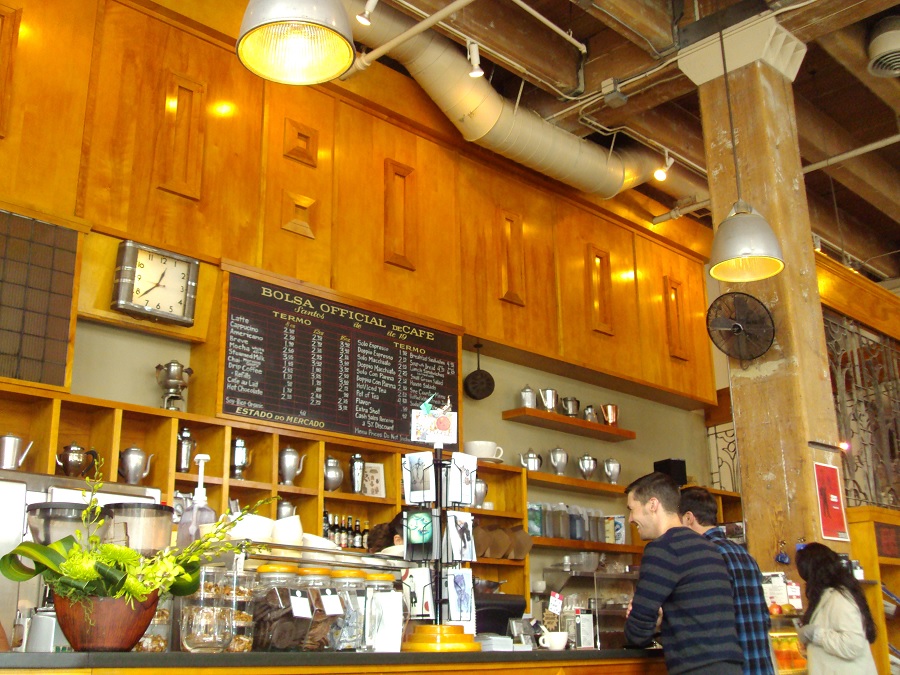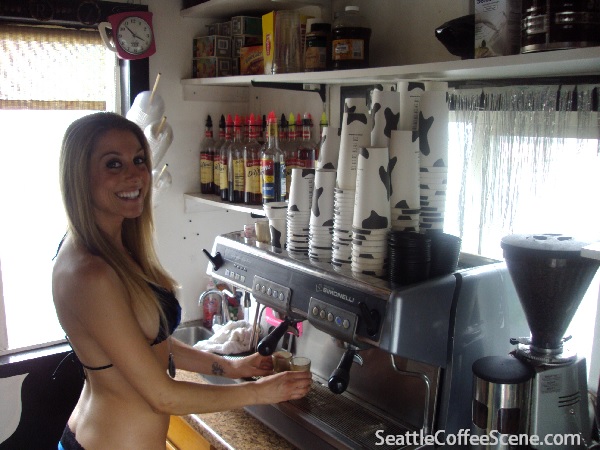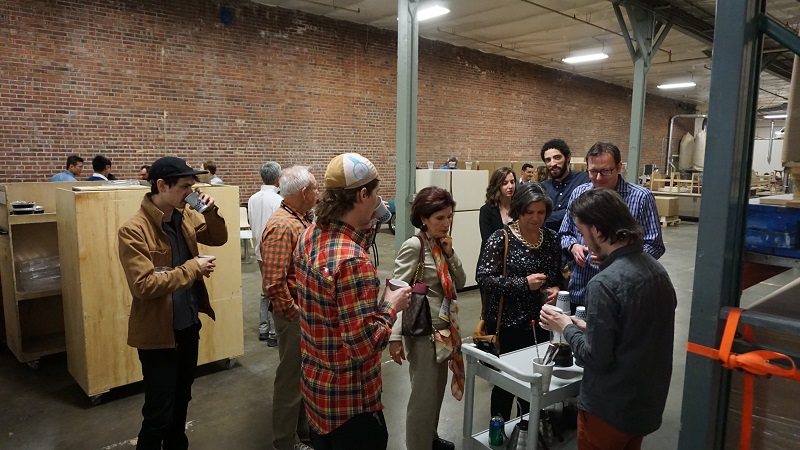
Conducting a taste-test demonstration at Fulcrum Coffee Roasters, Seattle, WA.
UW Grad Just Figured Out How to Decaffeinate Your Coffee After It’s Been Brewed
Seattle Just Might Change The Way The World Drinks Coffee… Again
Coffee lovers either hate or love decaf. Particularly because, while it has reduced the caffeine in coffee – it can dramatically impact the taste. Additionally, the variety of methods to get to decaffeination can be harsh, costly, and possibly bad for the environment.
The surge of great coffee over the last 15 years by artisan roasters have left decaffeinated beans behind. Much of the time because of the lack of available good single origin beans, the higher costs, the less demand, and the taste.
But what if there was a different way to decaffeinate our beloved coffee?
A Seattle-based startup has actually done it. Started by Andy Liu, a former UW grad student decided to use his Master Capstone project to solve one of the coffee scene’s biggest mysteries: Decafino has figured out a way to decaffeinate coffee, after it has been brewed.
Decafino has been able to develop a natural way to remove caffeine, without impacting the taste of your coffee beans.
I recently took part in a taste test and could not tell the difference. I wanted to learn about Decafino (And share it with you!).
Here’s my interview with Byran Chen, the new company’s V.P. of Business Development:
What does Decafino do? (And how does it do it?)
Decafino’s unique, patent-pending technology allows the consumer to decaffeinate any beverage with our product – The Decaf Pouch. The Decaf Pouch decaffeinates either during brewing or post brewing. It is extremely easy to use and instantly solves the problem of limited decaf options. It is also highly selective to caffeine and does not negatively affect the rich flavors and aroma of regular coffee.
Decaf pouch is made from all-natural, food grade materials. Our novel decaffeination method uses physical phenomenon known as adsorption to selectively extract caffeine without leaving anything in the beverage. Unlike current decaffeination methods, our technology does not require large energy consumption nor does it use any volatile chemicals. Therefore, our product is significantly more environmentally friendly and preserves our sustainability value.
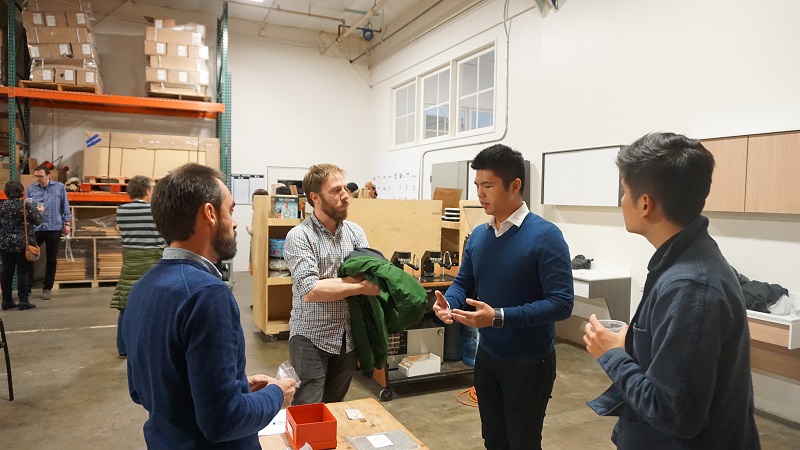
Decafino’s Any Liu talks with taste testers in April 2017.
The Taste test was held at Fulcrum Coffee Roasters in Seattle.
How was decafino born? (Take us through the proceess – Student Capstone project to winning startup funds.)
Late 2015, Andy’s chemical engineering senior capstone team originally thought of ideas to increase the level of caffeine in beverages at first, later to realize the lack of need in the market. The team then pivoted to creating a product that aims to remove caffeine in any caffeinated drinks.
We participated in the Environmental innovation challenge in March 2016. Though we didn’t receive any prize, we got a lot of compliments and feedbacks regarding our new methodology and pivoted our pitch and target towards more on the quality of our beverage.
May 2016, Decaf Style, created by Andy and a few others, entered themselves into the biggest student based competition in the Washington State, the UW Business Plan Competition. The UW BPC promotes student ideas and new venture creation, as well as providing an opportunity for business and science students to present new business plans to Seattle area venture capitalists, entrepreneurs and investors. Out of 93 teams, Decaf Style got second place and we were rewarded $10,000 as well as a special REI Best Retain Innovation Idea prize of $2,500. Decaf Style also joined the Jones & Foster Business Accelerator Program.
During the competition, the Chemical Engineering department hosted a board meeting that discusses all the relevant events happening in the department. Professor Lilo Pozzo showed great interest in raising entrepreneurship awareness in the engineering program, and asked Andy to represent Decaf Style to give a talk during the board meeting. Professor Pozzo then connected Andy with Camillo Cheng, a Seattle expert in specialty chemicals industry as well as food and beverage businesses. Mr. Cheng has since then jumped on as an advisor and helped the team come up with an executive plan for the launch of the business.
The startup process can be messy and unpredictable – licensing IP, producing prototype, customer profiling and market research – all are critical and daunting. After the first few months, Andy’s one-man show drained his energy, he realized that his effort is best put into R&D, to perfect the product and customizing to market need. Bryan Chen, a student entrepreneur from Buerk Centre for Entrepreneurship, who met Andy through the introduction by President of CENUW, jumped on board and took over the business development side of Decaf Style. In that 6 short months, the team licensed for provisional patent, found a manufacturing facility, conducted interviews with 4 roasters in Seattle and received an additional $10,000 in funding. At the end of the program, Decaf Style changed its official name to Decafino, Inc.
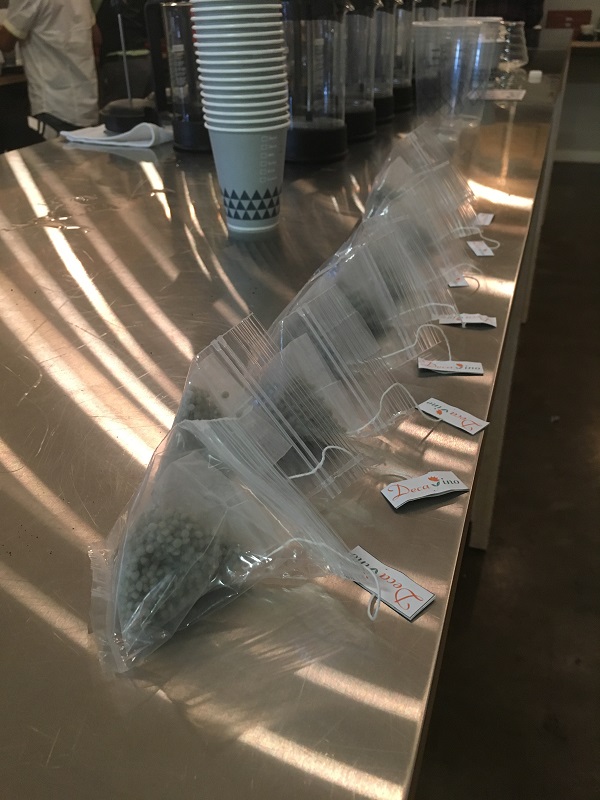
Dacafino comes in little tea-bags, are natural, and effective at removing caffeine from brewed coffee.
What are the benefits of using Decafino (compared to other methods of decaffeination)?
Please excuse the bullet points, Decafino significantly beats traditional decaf in benefits, so I’d like to be as precise as possible.
- Great Flavor: The decaf pouches remove primarily caffeine molecules without effecting the flavor. Therefore, our decaf retains excellent taste compared to traditional decaf coffee.
- Wide Selection: With our technology, decaffeination occurs during or after brewing. Compared to the current methods that happens on the green bean level, we offer the ability to decaffeinate any coffee selection a café carries, anytime.
- Personal “In-Cup” Technology: Not only cafes, in some catering events or corporate functions, decaf coffee may have to be brewed in a large batch, and a significant portion goes to waste. With our pouches, caterers can purchase and brew only regular coffee as consumers can now decaffeinate personally as they wish.
- Natural Minerals and Natural Polymers: There is a dilemma with some roasters hesitating to send their higher-end beans to get decaffeinated due to sabotaging taste as a result, so most of the decaf offered to the end consumers are usually lower-grade beans/coffee. Since our pouches don’t impact the flavor, some roasters are planning on using our pouches for their high-end roasts.
- Biodegradable, Chemical–Free and Energy Efficient: As mentioned, all of our materials are natural and biodegradable. Some current decaf processes may use volatile organic solvents that degrade the environment.
- Efficient Process: Though consumers can purchase their decaf right now without a long wait, the actual decaffeination process usually takes 8-10 hours to complete. But now, we’re looking at decaffeinating your cup of coffee in a matter of minutes.
In a broader sense, it may be unfair to compare our technology to the current available processes, since decaffeinating post-brew is really one of a kind. Because this technology is so new, we’re also learning new additional benefits of our product as we market ourselves to different parties.
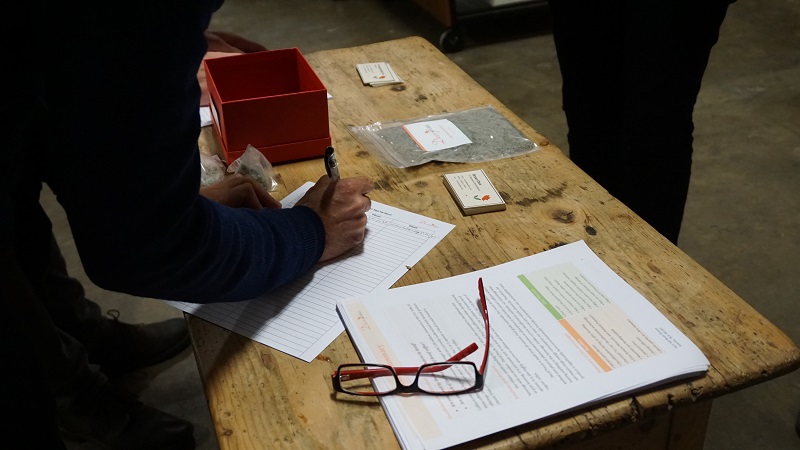
Do you have patents pending?
We are working on our patents currently, and we plan to file the world patent by 5/18. Then we’ll become patent pending.
How has Decafino been received by coffee roasters/tasters?
Decafino has had conversations and blind taste tests with 8 different roasters in Seattle, and the comments we have received are:
“Wow, I really couldn’t taste the difference.”
“Your decaf tastes sweeter and smoother, doesn’t have a bitter after taste, and personally, I think that’s awesome.”
“You know, I can sort of tell this is decaf because it’s not as acidic as the regular. But honestly, if I don’t have a regular cup to compare, I really wouldn’t know.”
“Interesting, your decaf doesn’t taste like sh*t!”
We’re always overwhelmed by the positive energy and feedback each roaster has given us. After the taste test, they would usually ask us about the material and how the process works. We’d give them our details as well as our price point.
“Great, let us know when you start manufacturing, and we’ll buy!”
We love the coffee roasters in Seattle.
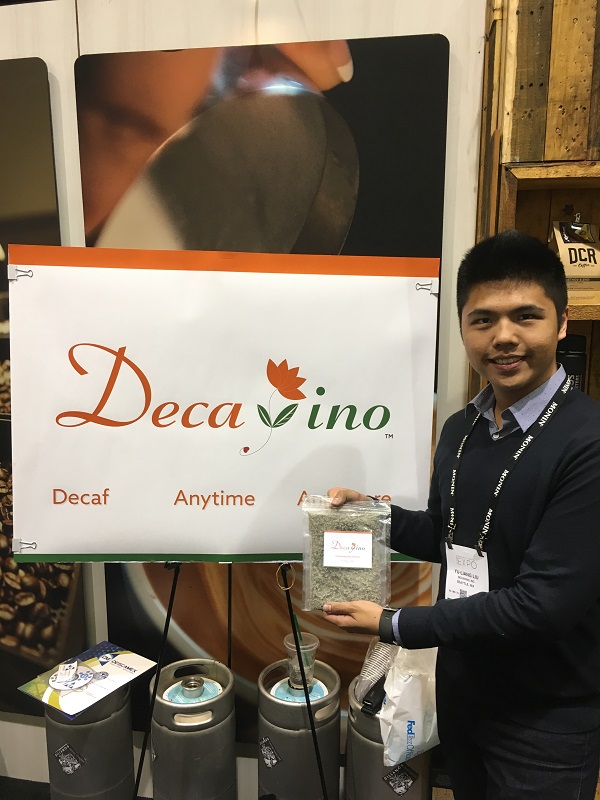
UW Grad and Decafino President, Andy Liu.
How will Decafino change how people drink coffee?
There are two different types of coffee drinkers: ones who drink for the effect, and those who drink for the taste.
For the latter, there is a significant unmet need in the coffee world for affordable, high-quality, low-caffeine coffee that can be served anytime, anywhere. Imagine a roaster hosting a coffee tasting event that’s happening tomorrow at 2pm. A lot of people would be scared of consuming large amount of coffee in the afternoon, as they’re sensitive and would also like to fall asleep at a reasonable hour. The current way of avoiding the problem would be to spit out the coffee after you’ve tasted it with your tongue, but let’s be honest, that’s, very literally, a buzz kill.
During the Global Specialty Coffee Expo, we’ve had a lot of exciting conversations with people who love coffee so much that the idea alone of being able to have a nice cup of coffee before going to bed drives them wild.
We’re not looking to turn regular coffee drinkers into drinking decaf. We’re looking to expand the market of coffee drinking as a whole! Not only will roasters be able to showcase the best roast they have in house anytime they want, the consumers will no longer be restricted to all the negative benefits that caffeine and low-quality decaf carries. For some, it’s all about the energy boost. But for a larger group of coffee lovers, it’s about the culture, the taste, the environment and the experience.
How do you envision Decafino being used (for example, will Decafino only be used in cafes, or for home/personal consumption).
There are so many opportunities for Decafino. In the beginning, Decafino have been approaching various cafés and roasters to see the demand for carrying our decaf pouches. We can use this as a step to gain customer feedback and further understand the market as well as perfect our product.
At a later stage, Decafino will be available at your local market places and convenient stores for home/personal consumption. This will be the end goal for us.
But in between the two targets, we’re still discovering opportunities that lie within. Catering companies and high-end restaurants that also serve coffee on a regular basis and decaf at nights. Hospitals and nursing homes that may have demand for quality decaf due to caffeine intolerance. Hotels and other forms of hospitalities may also cut out their decaf beans purchases completely and offer our personal “in-cup” technology to reduce waste and costs.
What are some of the challenges Decafino faces today (challenges as a company and as a product)?
As a company: reaching out to different people in different industry are difficult sometimes since we’re not well-known to the public yet, nor do we have a large sales force. Coffee industry has existed for a long time now, breaking current operation and service system isn’t an easy job, therefore trying to introduce a new concept may cause hesitation from traditional roasters.
We’re also working on educating the end beverage consumers on how decaffeination really work. Since many of them do not know the drawbacks of current processes, it also takes a lot of time to spread the word with our current resource.
Product wise: how we design the product is really important; we need to have positive user experience. But before doing that, we need to define who really is the user, the barista or the customer. Packaging is also a little tricky. We can view it in two areas: first being the volume of the beverage (what size of coffee do decaf drinkers typically order), and how we can customize our sizes to custom fit different end users.
Where did you get your inspiration to start this project?
Andy is a chemical engineer by training who really cares about people’s health as well as the environment. Soon after he found out that 70-80% of current decaf coffee is made from chemical solvent process that’s potentially harmful to the human bodies, he decided to contribute his expertise and take action.
When did you realize that you hit something big?
Our first ever taste test was so-so, due to using a low-quality coffee. However, as we proceeded from the environmental innovation challenge to Business Plan Competition, we received a lot more feedback from experts in the industry and performed more taste testings. That’s when we realized the high texture profile of our technology and gained confidence that this may be something exciting for the coffee scene.
The first jackpot was definitely getting second place in the BPC. The way investors got excited over hearing the technology and resisting the urge to roll up their sleeves to jump on board was a clear indication that this has the potential to be a huge win. The judges of the BPC came from all different backgrounds, and we were able to gain a lot more exposure from various experts’ opinion.
How do you see Decafino changing coffee drinking habits?
We expect to increase the number of people drinking decaf, as well as the total number of coffee drinkers as a whole. Some roasters are concerned about the low amount of decaf sales in their stores. However, we’re not looking to convert their regular coffee drinkers into drinking decaf, but instead, attracting more people who previously couldn’t drink caffeine, to enjoy a nice up of beverage of their choice.
In a logistical sense, we’re hoping to simplify the inventory and decaf orders coffee providers have to go through in their retail and wholesale accounts. Decafino is offering the power to turn all types of coffee decaf. We personally know that a lot of hospitality chains could really benefit some a simplified inventory system.
In a general sense, there has been way too many debates regarding the benefits and drawbacks caffeine does to your body. Having to enjoy a cup of your favorite beverage while worrying about the negative effects is simply not necessary. Try Decafino, and get great decaf, anytime, anywhere.




